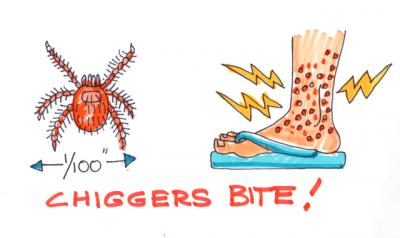Nature Notes: Chiggers or Not, the Itch Is Real

I led a nature walk at Shadmoor State Park for a nice couple from Amagansett who won the walk in the East Hampton Ladies Village Improvement Society auction held on July 30. Their son and a girlfriend, as well as another woman friend and her son, also accompanied us. I took my large white towel along and swept the vegetation on the sides of the trails as we marched on in the chance that I might find a tick or two. Shadmoor is well known for its large deer tick and Lone Star tick populations.
We walked a bit more than two miles and the towel didn’t pick up a single tick. However, it did pick up a some seeds of a species of tick-clover, which have little barbs for clinging to animal hairs to maximize the dispersion of the species. When I got back to Noyac I checked my body and my clothing very carefully: completely tickless.
However, the next morning I woke up to some itchiness on my calves and ankles. I examined the causes and discovered five small pustules, white in the center, red around the edges — two on one leg, three on the other. Uh-oh. Chiggers, I thought! I went all last year without one chigger bite, but being in the field in Montauk in September of any year is an invitation to mayhem. I led people on a similar walk at Shadmoor in early August of last year and didn’t get a single tick or chigger. I should have known better this year.
The Cornell Cooperative Extension of Suffolk County, experts with respect to local tick populations, say that there are no chiggers on Long Island, but that we are actually dealing with the larvae of local ticks.
I and several other non-entomologists beg to differ. Ask Peggy Conklin for example. She and I are of about the same age. She grew up in East Hampton and remembers chiggers and their bites as a young girl in the 1940s. In Mattituck during those years when I and my brothers and sisters would go berry picking in the woods and fields near our house, before we set foot out the door, my mother would warn us to be on the lookout for chiggers.
There were wood ticks (also called dog ticks) around in those days, but not the deer or Lone Star ticks. They showed up here in the 1970s and 1980s, respectively.
Adult chiggers are variously known as red bugs, chigoes, harvest mites, and by many other vernacular names throughout the United States. They are more common in the South than here. In fact, in one small Texas town they are so common that the townsfolk there actually celebrate an annual Chigger Day. But I believe we have them as well.
Like adult ticks, chiggers have six legs as adults, but start out with eight legs as larvae. The larvae don’t bite; they extend a tubular mouth part down one of the skin’s hair pores and thereby secrete digestive fluids to feed on the flesh. They remain there until sated, drop off, and metamorphose into nymphs, just as ticks do. The nymphs feed on vegetation and the adults they eventually become are also plant eaters. The ticks that we deal with here are meat eaters throughout their entire life cycle.
Two common tick species that cause us problems are Trabicula alfreddugesi and Trabicula autumnalis from Eurasia. The “autumnalis” suggests that the larvae make their appearance in the fall, and that is when I’ve noticed that chiggers in Montauk’s wilds have been the most prevalent since I began going into the field there regularly in the 1980s. In fact, last year was the only one in the last 38 in which I didn’t suffer a single bite. Once, on a fall trip to Gardiner’s Island when Robert Gardiner was still holding down the fort, I came back with a serious case of what I’m sure were chigger bites.
The larvae of our tick species are tiny, but dark. I can make them out against the pale background that my skin provides. Every once in a while I find an adult Trabicula tick on a plant in my yard. I can see it with the naked eye, red against a green-colored leaf, a little bigger than the head of a pin. But I can’t see the reddish larvae, as small as .2 millimeter in size, with my naked eye. I only notice them after the fact, when the itching starts and the pustules appear, by which time they are gone. I have found a few larvae and put them under the microscope, where I can see them and even count their eight legs.
Interestingly, chiggers don’t appear to be vectors of diseases the way ticks and mosquitoes are. But sometimes after two weeks of scratching I think I’d rather have a disease that I can cure in a day or two with a dose of antibiotics than suffer the slings and arrows of bites that seem to last forever.
The best way to avoid the discomfort is to stay out of the woods and grassy fields in September and October. There are chigger cures available in most drugstores. I don’t know if they work or not, as I have never tried them. What I do is pierce the pustule with a sharp needle and apply rubbing alcohol. Such an antidote can sting like hell, but somehow the pain is better than the itch.
Larry Penny can be reached via email at [email protected].
